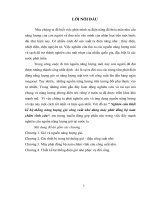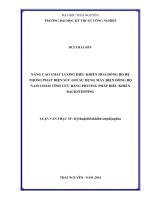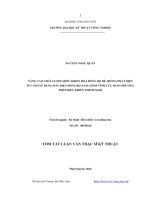Tính toán và thiết kế điện từ động cơ đồng bộ nam châm vĩnh cửu 2,2kw ứng dụng cho máy gia công CNC
Bạn đang xem bản rút gọn của tài liệu. Xem và tải ngay bản đầy đủ của tài liệu tại đây (1.14 MB, 4 trang )
SCIENCE - TECHNOLOGY
P-ISSN 1859-3585 E-ISSN 2615-9619
ELECTROMAGNETIC CALCULATION AND DESIGN OF A 2.2kW
INTERIOR PERMAGNENT MAGNET SYNCHRONOUS MOTOR
WITH APPLICATION TO CNC MILLING MACHINE
TÍNH TỐN VÀ THIẾT KẾ ĐIỆN TỪ ĐỘNG CƠ ĐỒNG BỘ NAM CHÂM VĨNH CỬU 2,2kW ỨNG DỤNG CHO MÁY GIA CÔNG CNC
Dang Quoc Vuong*,
Nguyen Quang Dich, Bui Minh Dinh
ABSTRACT
In this paper, a type interior permanent magnet motor designs is proposed
for computer numerical control milling machine application as spindle motors.
An existing surface mounted permanent magnet motor is used as a reference
motor. The I type interior permanent magnet motor alternatives is designed and
optimized in detail. The electromagnetic results of interior permanent magnet
motors are compared with the reference surface permanent magnet motor for
the same design requirements. The detailed loss analysis is also performed for
the desired motor structure at high speeds. A prototype motor is manufactured
and initial experimental tests are also performed. The detailed comparison
between finite element analysis and test data are also presented. It is shown
that it is possible to have an optimized interior permanent magnet motor for
such a high speed spindle application.
Keywords: Interior permanent magnet motor - IPM, spindle motor for milling
machine, I-type IPM, Finite element method - FEM.
TÓM TẮT
Trong bài báo này, thiết kế động cơ nam châm vĩnh cửu gắn trong được đề
xuất cho ứng dụng máy gia công điều khiển số máy tính như là động cơ trục
chính. Một động cơ nam châm vĩnh cửu gắn trên bề mặt được sử dụng như một
động cơ tham chiếu để so sánh kết quả. Động cơ nam châm vĩnh cửu kiểu I được
thiết kế chi tiết và tối ưu hoá. Các kết quả điện từ của động cơ nam châm vĩnh
cửu gắn trong được so sánh với động cơ nam châm vĩnh cửu tham chiếu gắn bề
mặt với các yêu cầu thiết kế tương tự. Phân tích chi tiết tổn hao cũng được thực
hiện cho cấu trúc động cơ ở tốc độ cao. Một động cơ mẫu được sản xuất và các
thử nghiệm ban đầu cũng được thực hiện. So sánh chi tiết giữa phân tích phần tử
hữu hạn và dữ liệu thử nghiệm cũng được trình bày. Điều đó cho thấy rằng một
sự tối ưu hoá động cơ nam châm vĩnh cửu rotor gắn trọng được thiết kế và ứng
cho máy gia cơng ở tốc độ cao.
Từ khóa: Động cơ nam châm vĩnh cửu gắn trong, động cơ cho máy gia công,
kiểu động cơ IPM kiểu I, phương pháp phần tử hữu hạn (FEM).
School of Electrical Engineering, Hanoi Unviversity of Science and Technology
*
Email:
Received:15 October 2019
Revised: 27 November 2019
Accepted: 20 February 2020
Website:
1. INTRODUCTION
Permanent magnet (PM) synchronous motors are quite
popular in many applications due to their distinctive
benefits such as high efficiency, high torque density,
smaller size and relatively low current requirements [1-3].
They also have low vibration, and low acoustic noise levels
compared to other types of electric motors [4-7]. It is also
possible to obtain high torque quality in PM motors both at
low and high speeds. Such issue is quite critical especially
for high performance application such as servo motors,
spindle motors and direct drive applications. There exist
various methods in order to obtain high torque quality in
PM motors [1-7]. These methods include design
modifications both at rotor and stator sides such as using
different slot/pole combinations, skewing rotor or stator,
magnet grouping, adding auxiliary slots and so on.
This paper focuses on the development of an interior
permanent magnet (IPM) spindle motor for computer
numerical control (CNC) milling applications. A Finite
element method (FEM) analyses are performed and some
parametric optimizations are realized in order to achieve the
better torque quality and performance. The comparison of
the designed spindle motors with respect to the reference
surface permanent magnet (SPM) motor is also provided.
The prototype motor is manufactured and experimental
tests are performed. It is shown that it is possible to have an
improved IPM motor for such spindle application.
2. DESIGN AND FINITE ELEMENT MODELING OF SPM
AND IPM MOTORS
In this paper, a 2.2kW, 3000rpm surface mounted PM
motor is used as a reference motor. Firstly, an initial sizing
of the motor is carried out. Electromagnetic analyses are
performed for the reference motor and then two different
IPM rotor designs are realized. The I type IPM motor design
alternatives is investigated in detail using the FEM and
several parametric optimizations are also performed before
finalizing the design.
Vol. 56 - No. 1 (Feb 2020) ● Journal of SCIENCE & TECHNOLOGY 25
KHOA HỌC CÔNG NGHỆ
P-ISSN 1859-3585 E-ISSN 2615-9619
2.1. Analysis of Reference SPM Motor
A reference SPM motor specifications used in this study
are given in Table 1. The reference motor is an integral slot
motor with 36/4 slot/pole combinations.
Table 1. SPM parameters
No
1
2
3
4
5
6
7
Parameters
Power (W)
Speed (rpm)
Stator (Slots)
Rotor (poles)
Rotor Outer Diameter (mm)
Stator Outer Diameter (mm)
Stack length (mm)
Value
2200
0 - 3000
24
4
98
150
125
The layout of stator and rotor lamination is shown in
Figure 1, with 24 stator slots and 4 magnetic poles, and the
maximum speed is 3000rpm and 1500rpm for the normal
speed. The current waveforms are the square shape
because the surface magnetic mount is equal to air gap
(Fig. 2). The efficiency of SPM is 88% and 5.22A/mm2 for
the current density (Fig. 3). From two limits above, we can
improve a new design of IPM to solve those problems. The
electromagnetic torque is kept as a constant at 14N.m from
zero to 1500rpm and down to 12N.m at 3000rpm. The
power is from zero to maximum value of 3800W at seed of
300rpm (Fig. 4).
Figure 3. Power and torque and speed
2.2. IPM design
In order to calculate the rotor diameter and slot length
of IPM, an analytical equation can be solved and given the
result. The most important factor is L/D ratio and torque
density must be estimated in the optimal range [8-12].
T= D L
. TRV,
(1)
where D is the outer rotor dimension, Lstk is the slot length
and TRV= 1525 kNm/m3.
In order to design the IPM servo motor with low inertia
moment, the L/D ratio is about from 1.4 to 1.6 [10], this
means that the motor structure with the long stack length
and the small outer rotor. It is easy to speed up and down
or stop, the basic parameters of IPM 2,2kW motor is shown
in Table 2.
Table 2. IPM parameters
No
1
2
3
4
5
6
7
Figure 1. Stator and rotor lamination
Parameters
Power (W)
Speed (rpm)
Stator (Slots)
Rotor (poles)
Rotor Outer Diameter (mm)
Stator Outer Diameter (mm)
Stack length (mm)
Value
2200
0 - 3000
36
4
80
132
130
The stator and rotor dimensions are important for
analytical model to calculate the electromagnetic
performance such as the toque, power and efficiency.
Figure 2. Current, EMF and Torque curves
26 Tạp chí KHOA HỌC & CƠNG NGHỆ ● Tập 56 - Số 1 (02/2020)
Figure 4. IPM Design of Stator and Rotor slots
Website:
SCIENCE - TECHNOLOGY
P-ISSN 1859-3585 E-ISSN 2615-9619
The electromagnetic torque Te and the currents (Id and
Iq) can be calculated vis the below equations, i.e,
T = mp ψ I − ψ I ,
ψ =ψ
+L I , ψ =L I ,
T = mp[(ψ
I + I I L − L ],
(2)
(3a-b)
(4)
I = −Isinγ, I = Icosγ.
(5a-b)
where Id an Iq are respectively the direct axis and
quadrature axis currents, ψ is the direct axis flux, ψ
is
the mutual direct axis flux, L is the direct axis inductance,
L is the quadrature axis inductance and γ is the phase
angle. The follow chart of calculation of IPM motor can be
obtained in Figure 5.
The most important factors of the IPM motor design are
ratios of E/U and Xq/Xd because they directly effect on the
efficiency and maximum torque. Normally, The ratio of E/U
is from 0.6 to 0.8 and from 3 to 6 for ratio of Xq/Xd. If ratio of
Xq/Xd is close to 2, then the reluctance torque is small. But
the ratio of Xq/Xd will reaches to 4, and the magnetic circuit
is saturated. If the ratio of E/U is less than 1, then the IPM
can work more in over flux or in saturation. The ratio of
Xd/Xq will make in decision about reluctance torque, and
the IPM has a big speed range being close to 4 values. The
electromagnetic torque Te is then defined as
T = mp[(ψ
Figure 6. Power and torque and speed
3. EXPERIMENTAL TEST RESULTS
In order to test the IPM of 2,2kW in 4 quard, the test
bench can be operated in 04 models as motoring and
generating, forward and reverse. Because this motor will be
used for the CNC application. Hence, it can stop in few
second and is kept at average torque at the rating level
(Figure 7).
I +I I L −L ]
=mp[(E I + I I X − X ]/ω
(6)
Figure 7. Full test bench system with maximum speed of 3000rpm
Rotor magnetic slots have been manufactured by wire
cutting after die-casting rotor bars and shaft assembly. The
back to back test bench of DC generator and the IPM motor
of 2,2kW has setup (Figure 7). The whole hardware of
torque and speed sensors is then built together and torque
results are displayed in interface control (Figure 8). The
designed motor is connected DC generator for testing in
every model.
Figure 5. Current, EMF and Torque curves
An improved efficiency is 92.9% with torque of 14Nm
and 1500rpm. The electromagnetic results of current,
voltage and torque waveforms have been presented in
Figure 5. The average torque is about 14Nm and torque
ripple of 7%. The power and torque curves are shown in
Figure 6 with maximum power of 4kW, and the average
torque is down from 18Nm to 12Nm at the full speed being
from 0 to 3500 rpm.
Website:
Figure 8. IPM servo motor control interface
Vol. 56 - No. 1 (Feb 2020) ● Journal of SCIENCE & TECHNOLOGY 27
KHOA HỌC CÔNG NGHỆ
The torque and speed curves have been tested and
measured in dynamic condition. The test results are good
agreement with designed parameters (Figure 9). The IPM
motor is setup to evaluate synchronizing speed under
different load and voltage by auto run test system as flow
IEC standard. All static and dynamic test result have saved
in IEC result template depicted in Figure 10. Maximum
efficiency is 89% at rated power and overload capacity is
125%, after comparing with design target, experimental
results are full agreement and over IE2 class.
Figure 9. Torque and speed results
Figure 10. Experiment result template in Quatest I
4. CONCLUSION
In this study, two different types of interior permanent
magnet motor designs are investigated for CNC milling
machines as a spindle motor. An existing SPM motor is
used as a reference motor. Two different IPM motor
P-ISSN 1859-3585 E-ISSN 2615-9619
topologies are developed for the same application. The
extensive FEA analyses and parametric optimizations are
performed and results are compared with the reference
SPM motor. The V-type IPM motor is manufactured and
tested since it has better torque quality and wider constant
power region. The detailed comparison between the FEA
and the test data are presented. It is seen that a good
agreement between the test data and FEA simulations are
obtained. It is concluded that the V-type IPM motor has
more benefits as opposed to SPM and conventional spoke
type IPM motor for such high speed milling applications.
REFERENCES
[1]. T.M. Jahns and W. L: Soong, 1996. Pulsating Torque Minimization
Techniques for Permanent Magnet AC Motor Drives-A review. IEEE Trans. Ind.
Appl., vol. 43, no. 2, pp. 321-330.
[2]. N. Bianchi and S. Bolognani, 2002. Design Techniques for Reducing the
Cogging Torque in Surface-Mounted PM Motors. IEEE Trans. Ind. Appl., vol. 38, no.
5, pp. 1259-1265.
[3]. X. Ge, Z. Q. Zhu, G. Kemp, D. Moule and C. Williams, 2017. Optimal stepSkew Methods for Cogging Torque Reduction Accounting for Three-Dimensional
Effect of Interior Permanent Magnet Machines. IEEE Trans. On Energy Conversion,
vol. 32, no. 1, pp. 222-232.
[4]. W. Q. Chu and Z. Q. Zhu, 2013. Investigation of Torque Ripples in
Permanent Magnet Synchronous Machines with Skewing. IEEE Trans. On
Magnetics, vol. 49, no.3.
[5]. W. Q. Chu and Z. Q. Zhu, 2013. Reduction of On-Load Torque Ripples in
Permanent Magnet Synchronous Machines by Improved Skewing. IEEE Trans. On
Magnetics, vol. 49, no.7, pp. 3822- 3825.
[6]. T. Li and G. Slemon, 2013. Reduction of Cogging Torque in Permanent
Magnet Motors. IEEE Trans. On Magnetics, vol. 24, no.6, pp. 2901-2903.
[7]. L. Dosiek and P. Pillay, 2007. Cogging Torque Reduction in Permanent
Magnet Machines,” IEEE Trans. Ind. Appl., vol. 43, no. 6, pp. 1565-1571.
[8]. J. Urresty, J. Riba, L. Romeral and A. Garcia, 2010. A Simple 2-D
FiniteElement Geometry for Analyzing Surface-Mounted Synchronous Machines With
Skew Rotor Magnets. IEEE Trans. On Magnetics, vol. 46, no.11, pp. 3948-3954
[9]. Z. Azar, Z.Q. Zhu and G. Ombach, 2012. Influence of Electric Loading and
Magnetic Saturation on Cogging Torque, Back-EMF and Torque Ripple of PM
Machines. IEEE Trans. On Magnetics, vol. 48, no. 10, pp. 2650-2658.
[10]. R. Islam, I. Husain, A. Fardoun and K. McLaughlin, 2009. Permagnent
Magnet Synchronous Motor Magnet Designs With Skewing for Torque Ripple and
Cogging Torque Reduction. IEEE Trans. Ind. Appl., vol. 45, no. 1, pp. 152-160.
[11]. H. Chen, D. Dorrell and M. Tsai, 2010. Design and Operation of Interior
Permanent-Magnet Motors with Two Axial Segments and High Rotor Saliency. IEEE
Trans. On Magnetics, vol. 46, no. 9, pp. 3664-3674.
[12]. C. Brecher, G. Spachthoz and F. Paepenmuller, 2007. Developments for
High Performance Machine Tool Spindles. Annals of the CIRP, pp. 395-399.
28 Tạp chí KHOA HỌC & CƠNG NGHỆ ● Tập 56 - Số 1 (02/2020)
THÔNG TIN TÁC GIẢ
Đặng Quốc Vương, Nguyễn Quang Địch, Bùi Minh Định
Viện Điện, Trường Đại học Bách khoa Hà Nội
Website:









